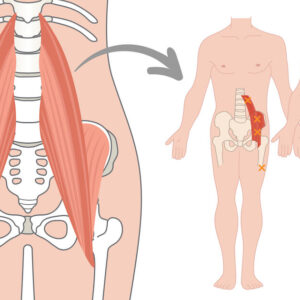Deep within the centre of your body, beneath layers of skin, muscle and organs, lies the psoas (pronounced “so-as”). While it can be a tricky muscle to target and stretch, with a little perseverance, it can be done.
The Psoas Muscle, Stress and Tension
The psoas muscle is the deepest muscle of the human body affecting our structural balance, muscular integrity, flexibility, strength, range of motion, joint mobility, and organ functioning.
It grows out of both sides of the spine. It spans laterally from the 12th thoracic vertebrae to each of the 5 lumbar vertebrae. From there, it stretches down through the abdominal core and pelvis, then finally attaches to the top of the femur (thigh) bone.
The psoas is one of the only muscles in the body that connects the spine to the legs. It is responsible for holding us upright, and allows us to lift our legs while we walk.
This muscle is also connected to the diaphragm through connective tissue (fascia), which affects our breath and fear reflex. According to Liz Koch who has her National Certification Board for Therapeutic Massage and Bodywork, a fast paced modern lifestyle (which runs on the adrenaline of our sympathetic nervous system) chronically triggers and tightens the psoas – making it always ready to run or fight.
If the psoas is constantly contracting due to stress or tension, the muscle eventually begins to shorten, leading to many different conditions such as (1):
– Low back pain
– Sacroiliac pain
– Sciatica
– Disc problems
– Spondylolysis
– Scoliosis
– Hip degeneration
– Knee pain
– Menstruation pain
– Infertility
– Digestive problems
A tight psoas muscle can also cause or contribute to a number of other conditions like hip pain, groin pain, uneven leg length, scoliosis, instability in the core of the body, and limited flexibility in the lower back (2).
How To Release a Tight Psoas Muscle
It is very important to exercise the psoas major to make sure it stays flexible, strong and healthy. Below is a sequence of relaxing and strengthening poses that release, lengthen and strengthen the psoas.
One of the most important things to remember when working with the psoas is somatic awareness (an awareness of what’s happening within your body). This requires training yourself to develop an awareness inside yourself and explore what’s happening within.
As you spend time in each pose and stretch, turn your attention inward. Sense where your psoas is located and feel if it is tight or loose, rigid or soft, tense or at ease. Learn to surrender, and breathe deep.
7 Yoga Poses To Help Release The Psoas
Check out the infographic below for how to perform these poses:
Here are instructions on how to perform each pose:
1. Constructive Rest Position
1. Lay flat on your back and bend your legs up at a 45-degree angle, ensuring your feet are flat on the floor, placed 12 inches from your bottom.
2. Tie a belt or exercise band around the middle of both of your thighs, and then rest. You can sit here and read a book. The goal is to stay here for 30 minutes a day, starting with 10.
2. Active Supine Stretch
1. While laying flat on your back, keep the left leg rested on the floor, and then bring your other leg back toward your body, placing your hands on your ankle and keeping it straight.
2. Pull your upper leg into your stomach and hold here for 30 seconds.
3. Release, and do the other side.
3. Pigeon Stretch
1. Come into a kneeling position, and draw in your left knee. Turn it out to the left so that your left leg is bent and near-perpendicular to your right one. Lower both legs to the ground.
2. Keep your right back leg extended straight behind you, and stabilize yourself with your elbows on the ground, or if you feel comfortable, fold your upper body forward and collapse over the left leg to a fully relaxed position.
3. Stay in this position and hold for 5-10 deep breaths.
4. Switch to the other side and repeat.
4. Standing Swing
1. Stand up straight on a yoga block (or something similar), and place your hands on your hips.
2. Stand firm in your left leg, with the knee slightly bent.
3. Keeping your right leg straight and locked, with your foot pointed, swing it out to your front and then back to the standing position.
4. Repeat this 15 times, and perform the same exercise on the left leg.
5. Do 3 repetitions on each leg.
5. Mountain Pose
1. Ensure your thighs are firm by grounding yourself, and then lift your kneecaps, strengthening the arches of your inner ankles as you lift them.
2. Gently turn your upper thighs inward, and look slightly upward.
3. Breathe in and stretch your arms, shoulders and chest upwards, while raising your heels and placing your body weight on your toes.
4. Hold the position for 30 seconds, and then release while exhaling.
6. Tree Pose
1. Begin by standing tall, with your legs slightly apart and your hands hanging freely by your side.
2. Shift your weight onto the left foot, keeping it firmly on the floor.
3. Bend your right knee, reaching down and grasping your right foot with your right hand.
4. Bring your right foot up, and place its sole against your inner left thigh.
5. Rest your hands on your pelvis and then firmly press the sole of your right foot against your inner thigh, and resist it with your left leg. You want to keep your tailbone tucked, so resist the urge to rotate the pelvis (aka. “duck butt”).
6. Press your hands together and focus on a fixed point in front of you.
7. Hold for one minute, and then exhale and emerge back into standing position. Repeat with the left leg.
7. Twisted Lizard Pose
1. Begin in a downward-facing dog pose, and bring your left leg forward.
2. Place the left foot on the outer side of your left palm and then place both of your forearms on the floor.
3. Lower your right knee to the ground, while stretching back as far as possible.
4. Bend your right forearm so that your fingers point to the left, then bring your left hand up and hold the toes on your right foot.
5. Remain in this pose for one minute before repeating the pose on the other side, starting on your right leg.
8 Exercises for Psoas Strengthening and Releasing
1. Leg Lifts
1. While lying flat on your back, bend your legs so that your feet are flat on the floor.
2. Extend the right leg out in front of you and place your hands at your sides.
3. With your back firmly flat against the floor (tuck the pelvis), lift your right leg above the ground and hold for five seconds.
4. Perform 8-12 repetitions on each leg.
2. Thomas Stretch
1. Perch yourself on a high and sturdy surface, such as a table, and allow your thighs to rest half-way off it.
2. Grab onto your right knee, and pull it into your chest. Let your left leg hang freely.
3. Lean back slowly until your lower back is flat on the surface.
4. If you have a partner, you can get them to push down on the knee of the left leg that is hanging freely. This will make the stretch more effective.
5. Hold for 30-60 seconds and then repeat three repetitions on each side.
3. Kneeling Lunge
1. Take a kneeling lung position on the ground with your front leg at a 90º angle in front of you.
2. Posteriorly tilt your pelvis (tuck your tailbone under, glutes tight), and shift your weight forward toward the front knee, while maintaining the posterior pelvic tilt.
3. Be sure not to curve the lower back – keep your tailbone tucked.
4. Stay here for 30 seconds to 1 minute. Relax, and then repeat on the other side.
5. Perform 3-5 repetitions on each leg.
4. Frankensteins Exercise
1. Start by walking like frankenstein, kicking one leg up, and reaching toward the opposite hand.
2. It’s important to keep your spine upright, and kick your leg up as high as you can. Don’t have your body forward flexed as you’re kicking – if your hamstring flexibility is limited, and you can’t kick up to shoulder height, you can still do the exercise with a lower kick. Only go up as high as your hip level. As you become flexible over time, you’ll be able to kick higher and higher.
3. Do 15 repetitions on each leg, and perform 3 sets.
5. Lying Psoas March
1. Place a small resistance band around both feet, and lay down on your back, feet extended.
2. Bring your right knee up towards your chest by flexing at the hip.
3. Try and pull your knee up past the line of your hips, and from here, bring the leg back down and attempt to repeat the exercise with the opposite leg.
4. Try to focus on keeping the inactive leg stable, and avoid any movement through the lower spine.
5. Do 10 repetitions on each leg for 3 sets.
6. Standing Gate Openers
1. Lift your right foot and flex your right knee, pulling it towards your chest.
2. With your thigh parallel to the ground, swing your knee to the left, across the centre of your body, and then to the right, opening your hips as much as you can.
3. Go back to the starting position, and repeat on the left leg.
4. Do 5-7 repetitions on each side.
7. Sit-Ups
1. Lay down on the ground with your knees bent and feet flat on the floor.
2. Place your hands behind your head, and curl your upper body up from the mat with smooth control. Don’t jerk yourself up and strain the neck. Instead, keep your back flat, neck straight, and use the muscles of your core to bring you up.
3. Do 3 sets of 10 repetitions.
8. Psoas Release with Ball
1. For this exercise you will need a lacrosse ball, which can be purchased online, or at a sports therapy store.
2. Lay on your stomach and find the hip bone. Place the lacrosse ball toward your bellybutton, just a little bit lower than the hip bone (about 2 finger breadths).
3. Holding the ball here, slowly roll onto the floor, putting your weight onto the ball.
4. Hold this position for 20 seconds, or up to 8 breaths. You can also pivot on this muscle, and you will likely immediately find it to be quite tender. This should allow the psoas muscle to release.
5. Repeat on the other side. You can do this up to 3 times per day if you are not too tender.
Four Tips for Maintaining a Healthy Psoas
The psoas can become tight and constricted by many different activities and unhealthy habits. Even menstrual cramps can be a sign of psoas muscle imbalance, as it places additional pressure on female reproductive organs (3).
To make sure this muscle stays loose and limber, make sure you try out the following:
1. Avoid Extreme Exercise
If you perform extreme exercise every day (like high intensity interval training, cross-fit, high-intensity weight lifting and lots of intense core exercise), you can create some adverse effects on the psoas major muscle. Consider alternating between gentle yoga and stretching one day, and then more high-intensity exercise the next.
2. Get a Massage
Getting a good massage therapist who is well educated on psoas release is another great way to help un-restrict this muscle.
3. Don’t Sit For Long Periods
If you need to sit for long periods of time, make sure you adopt a good posture, and avoid chairs without lower back support. If you have a sitting job, make sure you get up at least every hour to walk around (like re-fill your water or taking a bathroom break).
4. Take Breaks When Driving Long Distances
If you ever take a trip or have a job where you must drive long distances, stop every two to three hours for a stretch and walk around. You can also add a rolled-up towel or cushion at the base of your spine for added support.










Bravo, Calry!
This is amazing. I actually learned a few things myself (I will probably start walking like Frankenstein a lot more) 😀
Warm Regards,
Melanie
Thanks Melanie! Thanks for the awesome infographic 🙂
I had heard of the psoas muscle before but new nothing about it. I have been having a lot of hip and back pain for the past year. I have had three back surgery’s. The last putting in plates and screws to hold everything together. I assumed that was causing me all my problems. I went to the doctor he says no it has to be something else. Then I ran across this about the psoas muscle and what the systems are. I started doing some of the stretching exercises and working on the exercises to strengthen the muscles. I have had a lot of problems here with this I hope these exercises work for me.
What accommodations do you suggest for those of us who have replacement knees and cannot kneel any longer? Thank you.
I would probably try using a towel that is wrapped up or a yoga mat that is wrapped up and try kneeling on that? If you can’t kneel at all, I’d YouTube sitting psoas muscle exercises.
appreciate your information on the psoas muscle, etc. and how to loosen it. thank you. however my problem is so bad i cannot walk or even stand; i am bedridden. wish i’d found you a few years ago. my question is ,’do you have any exercises to do in a chair?” if you have any how can i get the instructions? thank you, again.
Hi Sue – I don’t have any that you can do in a chair, but if you can get creative and modify these to be done in a chair, I’m sure that would work!
How do I know if my Psoas muscle is tight or if my Quadratum Lumborum?
I’d check with a physiotherapist to make sure it’s the proper muscle group.